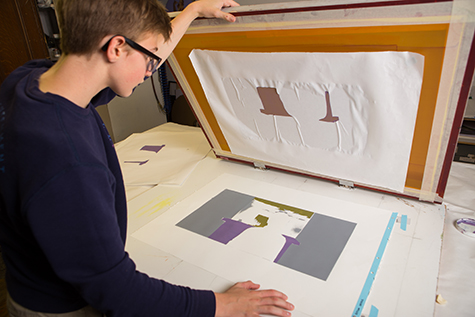The Vital Guide to Understanding Screen Printing and Its Versatile Utilizes
Screen printing has an abundant history that dates back to ancient times, progressing right into an advanced technique utilized across numerous sectors today. This overview checks out the complexities of the screen printing process, detailing its applications in style, marketing, and home decoration - 10:9 Design Screen Printing. Comprehending these principles can open imaginative capacity for both imaginative and business projects. The following areas will certainly expose vital tips and techniques to boost one's screen printing undertakings
The History of Screen Printing
Although screen printing has origins that map back centuries, its advancement reflects the technical and creative advancements of various cultures. Coming from old China, the strategy was initially made use of for embellishing textiles and later infect Japan, where it became essential to Ukiyo-e woodblock printing. The technique moved to Europe in the 18th century, where it gained popularity amongst artisans and business printers. The innovation of photo solution in the 20th century revolutionized screen printing, permitting even more detailed designs and higher performance. Musicians like Andy Warhol even more pushed its popularity, making use of the tool to create renowned jobs that mixed commercialism and art. By the late 20th century, screen printing had actually established itself as a functional strategy, used in fashion, marketing, and art. Today, it remains to progress, incorporating electronic technology and broadening its applications throughout different industries.
The Screen Printing Process Explained
Screen printing changes creative visions right into concrete styles via a series of accurate actions. An image is produced and then transferred onto a screen, usually made of fine mesh textile extended over a framework. A light-sensitive emulsion is put on the screen, which is revealed to light, hardening in areas not covered by the image. After rinsing the unhardened emulsion, a stencil is formed.
Next, the screen is positioned over the substratum, whether it be textile, paper, or another product. Ink is then pressed through the open locations of the stencil utilizing a squeegee, depositing the style onto the substratum listed below. This procedure can be repeated for several shades, needing separate screens for every tone. Lastly, the published item is healed using warmth to ensure the ink sticks appropriately, leading to a resilient, lively design on-line.
Kinds of Screen Printing Techniques

Additionally, specialized strategies, such as discharge screen printing, remove color from the material to create softer prints, while aluminum foil screen printing applies metallic aluminum foil to achieve a shiny finish (10:9 Design Abilene). Each method supplies unique attributes, satisfying various imaginative needs and manufacturing scales, inevitably increasing the possibilities within the screen printing domain name
Applications of Screen Printing in Various Industries

Furthermore, the signage and marketing sectors utilize screen printing for developing distinctive display screens and banners. This technique enables vibrant shades and elaborate designs that record interest. In electronics, screen printing is used for applying conductive inks to circuit boards, necessary for element connections. The home décor industry accepts screen printing to produce distinct designs on fabrics and wall surface art. In general, screen printing serves as a critical device across varied fields, enhancing items read more with personalized and aesthetically attractive graphics.
Tips for Effective Screen Printing Projects
While carrying out a screen printing task, cautious attention to detail can significantly enhance the last result. Initially, selecting high-grade materials is crucial; this includes the screen, inks, and substrates. Utilizing ideal mesh counts can impact ink deposition and detail resolution. Prep work is equally crucial; thorough cleaning of displays and correct direct exposure times guarantee crisp prints.
Next off, accurate registration is essential for multi-color prints. Utilizing alignment tools can assist achieve precise layering. Furthermore, testing prints on scrap materials prior to manufacturing aids identify potential problems without throwing away sources.

Often Asked Inquiries
What Materials Are Finest for Screen Printing on Textile?
Cotton and polyester blends are optimal for screen printing on textile due to their durability and ink absorption. Furthermore, specialized fabrics like silk or canvas can create special textures and surfaces, boosting the total design high quality.
Just how Do I Clean and Maintain Screen Printing Devices?
To maintain and clean up screen printing tools, one should routinely wash displays with ideal solvents, inspect squeegees for wear, lube relocating components, and shop all things in a dry, dust-free atmosphere to lengthen their lifespan.
What Are the Environmental Effects of Screen Printing?
Screen printing can have considerable ecological influences, consisting of chemical waste from solvents and inks, water usage during cleaning processes, and energy intake. Eco-friendly materials and lasting techniques are important for lessening these adverse impacts.
Can Screen Printing Be Done in the house Properly?
Screen printing can be properly done at home with the appropriate products and strategies. Enthusiasts can create high quality prints, though success depends upon their skill level, tools, and understanding of the procedure entailed.
What Are the Prices Connected With Beginning a Screen Printing Service?

Starting a screen printing business entails expenses for equipment, products, and office. Initial expenditures typically vary from a few hundred to numerous thousand dollars, depending upon the range, quality of machinery, and wanted manufacturing capacity.
Screen printing has an abundant history that dates back to old times, progressing right into a sophisticated strategy used across numerous markets today. An additional technique, rotary screen printing, uses cylindrical displays, helping with continual printing on fabric rolls, therefore enhancing effectiveness for large productions. Furthermore, specialty strategies, such as discharge screen printing, eliminate color from the fabric to develop softer prints, while foil screen printing applies metallic aluminum foil to achieve a shiny coating. In the fashion field, screen printing is commonly used to produce vibrant styles on garments, allowing brand names to showcase their one-of-a-kind styles. Cotton and polyester blends are excellent for screen printing on material due to their durability and ink absorption.